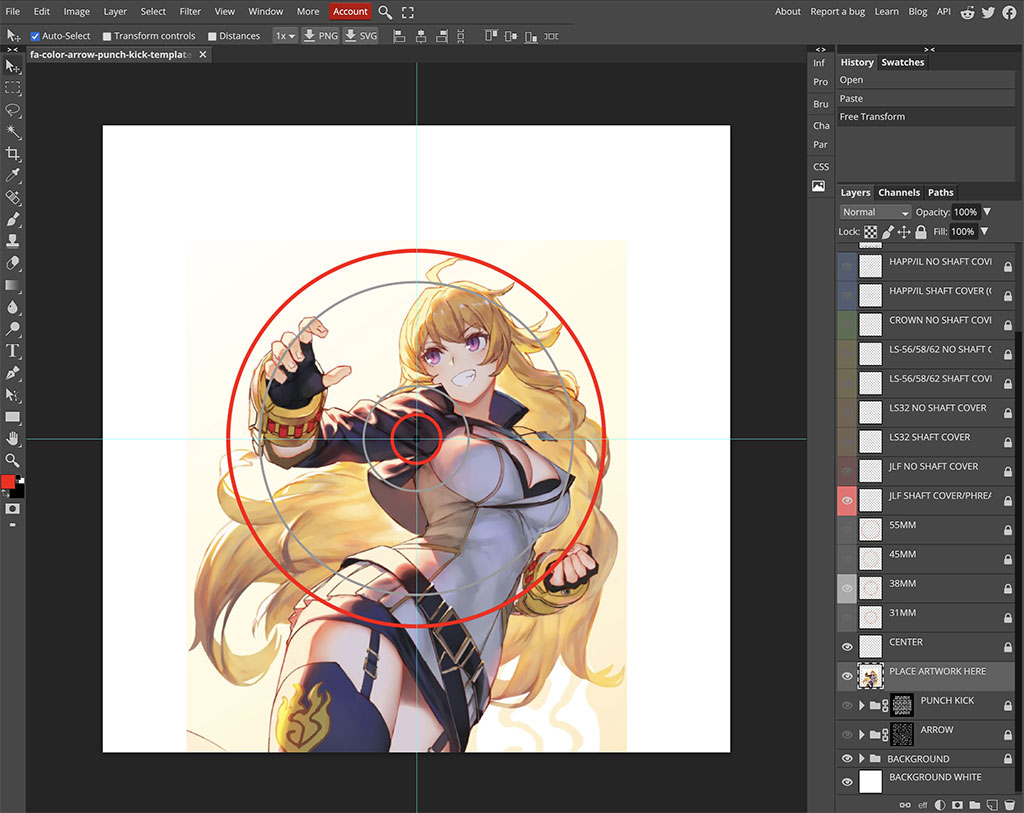- Category
- What's New?
- FightSticks/Pads
- Joysticks
- Pushbuttons
- Spare Parts & Tools
- Hardware & PCB
- Electrical
- Customize
- Merchandise
- Sales & Clearance
- Brand
PLEXWORKS CYBER PRE-SALE! 10-30% OFF ALL CUSTOM ART, PLEXI AND MORE [ INFO ]
Discount sale ends 11:59PM PST Tuesday December 2 (3:00am EST Dec 3)
Blank Plexi Cover for Hit Box Cross|Up
Choose Your Options
-
Product Description
Please Read Before You Order
Below is important information to know before placing a custom order with us:
- Project L Official Artwork: Do not submit the PNG samples. Instead, please download the zipped Photoshop PSD version, unzip the file and integrate them into our artwork templates
 for your desired fightstick model
for your desired fightstick model - Custom Orders do Not Ship Separately: If you place an order for a personalized product along with non-custom products, such as arcade part or merchandise, please note that all items will ship together.
The art cover replacement top panel offers one of the best ways to customize your joystick. The plexiglass sits atop specially cut artwork, allowing you to add or replace new custom artwork to match your joystick theme.
Designed for HitBox™ Cross|Up
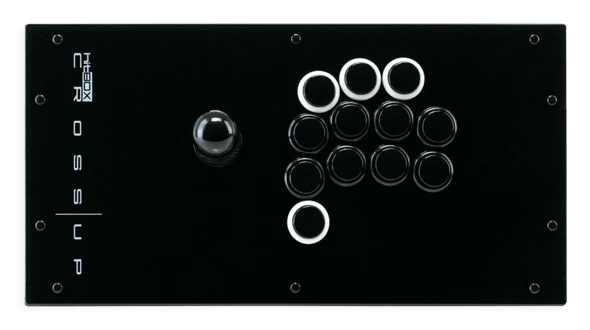
HitBox Cross|Up Template (2021 Retail Release. Not Kickstarter Alpha Layout. PS3/PS4/Nintendo Switch/PC, 2.1 Mb zip) The HitBox™ Cross|Up is a unique take on what is the company's flagship controller - the all-button HitBox. This model includes a joystick to replicate analog controls, while face buttons continue to represent directions. Please note that the .100" (2.54mm) plexi option is a hair bit thicker than the official panel, and does not have a curved top. The thinner .060" panel is available in black.
Legal: HitBox™ Arcade is not affiliated with this third-party customization in any way shape or form. It is not officially endorsed by HitBox™ Arcade.
Install Notes


We start with information on the Cross|Up top panel. Cross|Up, utilizes 30 millimeter buttons for all of its the buttons on the panel. If you are unsure about this size, we offer a helpful guide  explaining 24mm vs 30mm. Please note that the spacing of these buttons on the panel will make using screwbuttons quite difficult and in some cases impossible as the button screw ring will not have enough room to turn.
explaining 24mm vs 30mm. Please note that the spacing of these buttons on the panel will make using screwbuttons quite difficult and in some cases impossible as the button screw ring will not have enough room to turn.The underside of Cross|Up is a foam padding. Remove six screws, then lift the bottom panel. Of note for those curious, the four white buttons towards the back are 24mm, and non-Sanwa. 
The Cross|Up internal wiring consists of ground and signal wires. Ground is Black in color; signal consists of Red, Blue, Brown and White. The wire colors repeat on each button section. When re-wiring, please use this helpful guide, which shows the ground and signal wiring by color and connector. 

To remove the ball top, insert a flat head screwdriver into the base of the Sanwa JLF joystick lever shaft. Turn the ball counter clockwise to loosen it from the shaft threading. The screwdriver keeps the rotating shaft in place while turning the ball top. There are ten rivet snaps that hold the existing panel. You'll find each of these plastic rivets poking out of a hole on the underside of the unit. To remove them, you can use your thumb to push forward, a thumbnail, or flathead screw. Note that some of the rivets are in tight corners of the case. 
With the buttons, joystick lever ball top and original panel removed, the HitBox Cross|Up metal panel underside is exposed. 

Lay the printed and cut artwork atop the metal panel. You will then place a clear plexi panel atop the artwork and reinstall the rivets. Often we find that some customers find the artwork or plexi is offset when they try to install buttons. The reason why this occurs is that the screw holes on both original and our plexi are slightly larger than the original metal panel. This allows for a bit of space when positioning. Before installing the rivets, use your fingers to pinch the artwork and plexi between the button holes to align them with the button holes in the metal panel. 

It's time to install the clear panel. The rivet snaps displace the small stands in the bottom once the top cap is inserted. This expands the area around the rivet, locking it in place. Rather than attempting to insert both top cap and rivet button at the same time, try installing the rivet bottom first, then the top cap. This allows the bottom to remain compressed when inserting into the screw hole. Follow up by inserting the top cap, pushing downwards until it seats directly on top of the panel. 
With the rivets installed, begin re-installing your buttons, and screwing the ball top back in place. Given the amount of wires and buttons, it is a good idea to properly test your controls to confirm that the wiring is reinstalled correctly before closing up the bottom. Use the screws taken from Step 2 to fit the foam padded bottom panel back into place. Congrats! Options Help You have several options to personalize your control panel, such as button layout, removal of control panel or screws in some models
Jump to: LAYOUT | REMOVING DEFAULT ELEMENTS
Plexi Color, Thickness
Below are visual examples of available acrylic colors and thicknesses. Not all colors are available for each thickness, nor are the materials and thicknesses accessible for each Fightstick model. Some colors come in a specific thickness, and are too thin or thick to install properly on the Fightstick. Additionally, some material thicknesses do not allow for full etch, as the material can warp from the laser.
When multiple colors and thicknesses are available for your Fightstick model, you will find them within the options list.
Plexi Thickness



Plexi Color and Texture




 Clear (.75mm, 1.5mm, 3mm)Black Gloss (1.5mm, 3mm)Black Matte (3mm only)White Gloss (3mm only)White Matte (3mm only)
Clear (.75mm, 1.5mm, 3mm)Black Gloss (1.5mm, 3mm)Black Matte (3mm only)White Gloss (3mm only)White Matte (3mm only)Notes about Black Matte, White Matte & White Gloss
 Black Matte is available in .125" (3mm) thickness only. This color and material texture can be purchased without etching. For AllFightsticks models, you can use the black matte plexi panel as a full replacement for the metal panel.
Black Matte is available in .125" (3mm) thickness only. This color and material texture can be purchased without etching. For AllFightsticks models, you can use the black matte plexi panel as a full replacement for the metal panel.
 White Gloss and White Matte is available in .125" (3mm) thickness only. For AllFightsticks models, you can use the white matte plexi panel as a full replacement for the metal panel.
White Gloss and White Matte is available in .125" (3mm) thickness only. For AllFightsticks models, you can use the white matte plexi panel as a full replacement for the metal panel.White acrylic is also semi translucent - about 80% opacity. You could place a brightly colored artwork underneath for a cool effect.
Layout Configuration
Each Fightstick has its own characteristics, with some sharing similar elements, such as the popular Vewlix button layout. We will specify what options are available for each Fightstick. Below are the most common button layout configurations:
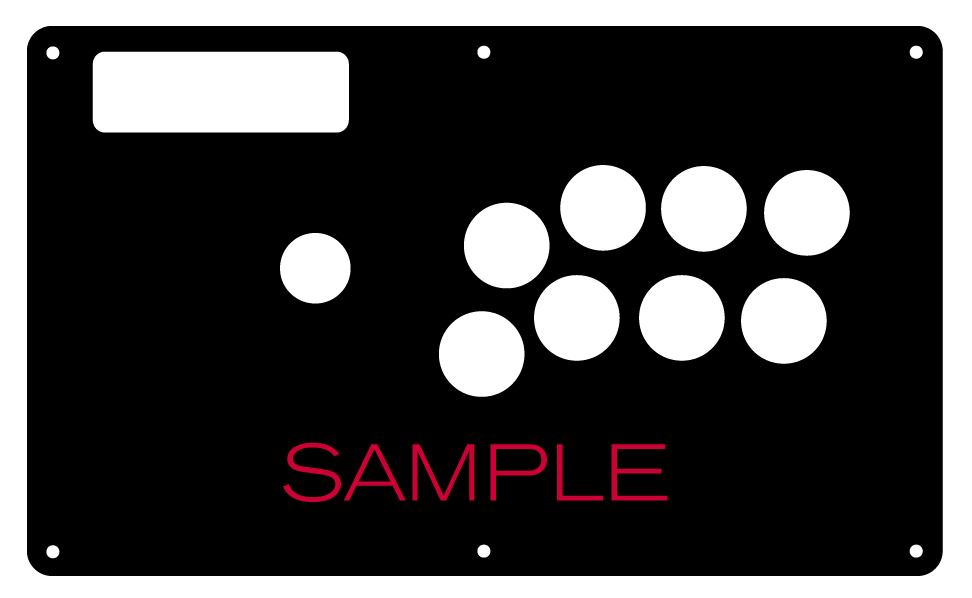
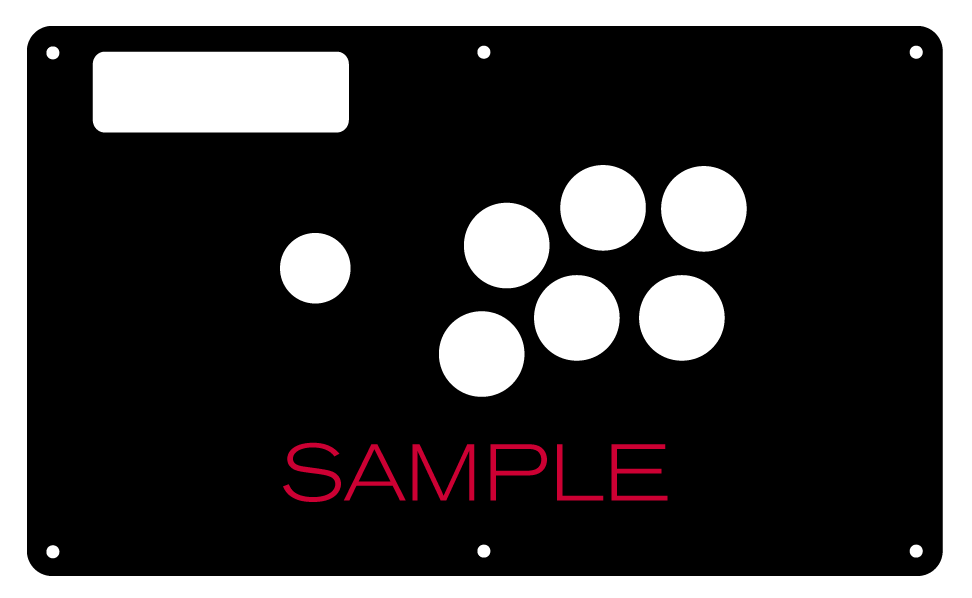
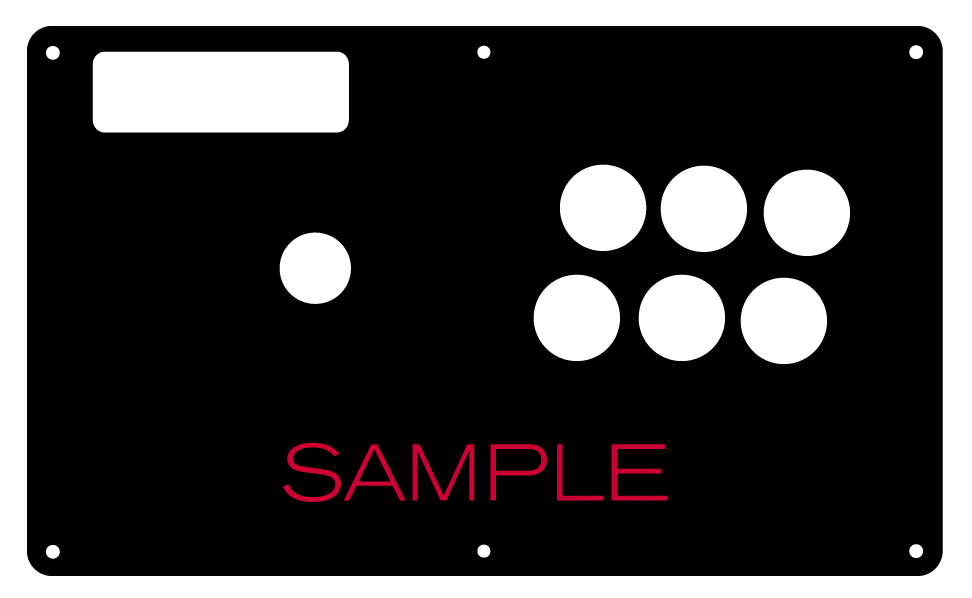
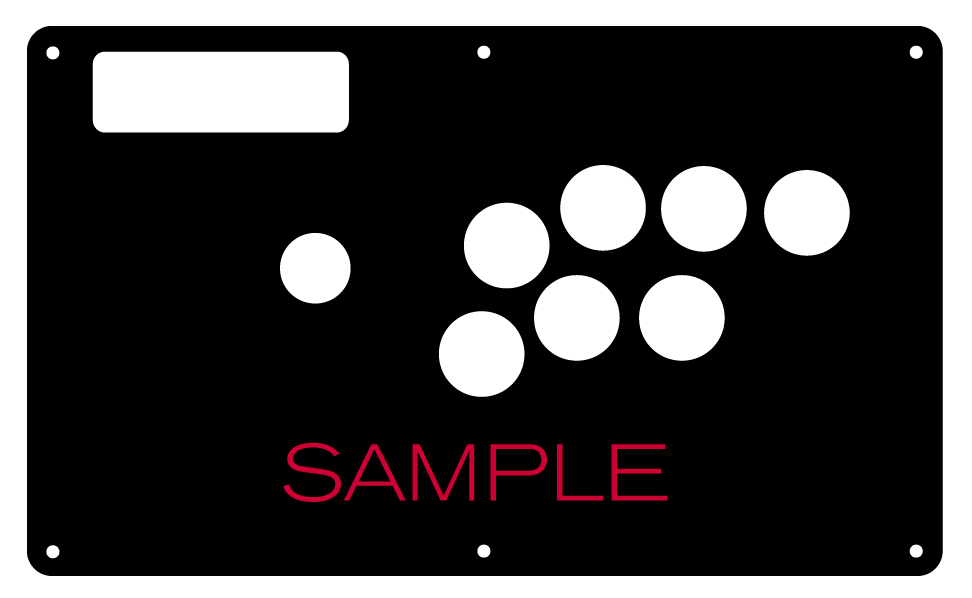 8 Button VewlixFirst 6 ButtonsLast 6 Buttons7 Button Vewlix
8 Button VewlixFirst 6 ButtonsLast 6 Buttons7 Button Vewlix
Removing Default Elements
Some Fightsticks, such as the popular MadCatz TE, offer additional personalization options by removing default elements such as control panel, start button, or screws. Cut options are defaulted to their authentic counterpart, displayed as [YES (default)] in the options list. For example, a MadCatz TE, the default configuration is to have the turbo/guide portion of the control panel cut, so that the control panel can fit properly. You have the option to select [NO] to prevent cutting these areas.
![Cut Control Panel? [NO]](http://support.focusattack.com/attachments/token/ioB7e1jzIXfxKdM8KJPKKzvKD/?name=sample-8button-noturbo.png)
![Cut Start Buttons [NO]](http://support.focusattack.com/attachments/token/SWbsx5sVHYupnBQ5iuZH1S2HK/?name=sample-nostart.png)
![Cut Middle and/or Bottom Screws? [NO]](http://support.focusattack.com/attachments/token/QzFj5pc5cNNHkOKrzlEMcc0I4/?name=sample-8button-nomiddlescrew.png) Cut Control Panel? [NO]Cut Start Button? [NO]Cut Middle and/or Bottom Screws? [NO]
Cut Control Panel? [NO]Cut Start Button? [NO]Cut Middle and/or Bottom Screws? [NO]
Cut Control Panel? [NO] - If you own a MadCatz TE, and installed a PS360+, you may no longer need the Turbo/Guide area of the control panel, located at top left. This option allows you to remove the Turbo/Guide portion. Please note that you MUST remove the actual control panel on the TE by unscrewing it before applying the plexi, or you risk damaging the plexi. Also, please make certain to select this option if you are also choosing to have artwork printed, or the plexi and artwork won't match.
Cut Start Button? [NO] - On some joysticks - such as the Qanba Q4 - the start button is directly on the panel. You can select to have this removed. You can also select this should you desire a panel similar to the Eightarc Fusion or Synthesis series Fightstick, as the start button is moved elsewhere. Again, this option is available on specific joysticks.
Cut Middle and/or Bottom Screws? [NO] - Selecting "no" on this option allows you to remove the middle top and bottom screw holes on specific joysticks, either for a cleaner appearance or to avoid rubbing your wrist against the screw. Please reconsider this option if you intend to have a full panel etch on your plexi, as etching physically changes portions of the plexi due to heat. In this case, it is best to leave the screw holes in place in order to keep the panel securely positioned.
Image Edit If you would like to use a free, online Photoshop-like app to check out whether your artwork will work with a layout we offer, I highly recommend Photopea
 This amazing app works with our PSD templates and is a great way to preview your artwork or create new art files. It also exports to PSD, which is the format we recommend for submitting artwork.
This amazing app works with our PSD templates and is a great way to preview your artwork or create new art files. It also exports to PSD, which is the format we recommend for submitting artwork.Support New to FA Plexworks?
Click the "Options" tab for a detailed explanation of each customization option available to you. Using a mobile device? Click here to scroll to the descriptions.
Artwork templates
We offer a photoshop template for each custom artwork or custom plexi etch. Click the "Description" tab (or scroll up if on mobile device) to display the template and download. You can also click here to access our repository and download artwork and etch templates (in Photoshop PSD format) for your desired model and others.
Important: Using templates outside of the ones we provide may produce unwanted output. We are not responsible for output generated from unsupported templates. More information here.
Warranty and Support for FA Plexworks Custom Order
Custom orders cannot be returned for refund, or exchanged for another custom order. Orders damaged upon arrival are subject to special terms within our return policy. Please see our FA Plexworks FAQ for more information about our Plexworks return policy and related Q&A.
If you have not used our Plexworks custom services before, we recommend that you visit our support section for updated information, helpful tips, and resources to get the best output.
Some useful sections to review before making your purchase (will open in new browser window or tab):
- Learn about our Custom Job Tracker to keep tabs on your custom order while staff processes it from start to finish.
- Save time getting answers by visiting our FAQ.
- Learn more about the personalization options available to you.
- Hire a skilled artist from the Fightstick Artists Network to visualize your idea.
- Handling the artwork yourself? Review our requirements and get tips to optimize your laser etch or artwork submission.
- Learn about additional products and services we offer under FA Plexworks.
- Project L Official Artwork: Do not submit the PNG samples. Instead, please download the zipped Photoshop PSD version, unzip the file and integrate them into our artwork templates
-
Product Reviews
-
Product Videos
-
 FA Plexworks Custom Fightstick Artwork ServicesThis video explains the many options available to you when cho...
FA Plexworks Custom Fightstick Artwork ServicesThis video explains the many options available to you when cho...
FA Plexworks Custom Fightstick Artwork Services
This video explains the many options available to you when choosing custom FA Plexworks services at focusattack.com. We also cover important tips and references for properly uploading artwork when placing an order. Visit https://www.focusattack.com/customize/ to place an order for custom Fightstick artwork, a replacement acrylic top, or even laser etched design on acrylic. For additional information about FA Plexworks, download templates, and additional tips on how to submit artwork, visit our support portal http://bit.ly/fa-plexworks-support Big thanks to Naota for his pro-tier production! ** Artwork pictures are sample illustrations. All printed artwork is submitted by the user, and not sold directly on the website. -
-
Find Similar Products by Category





